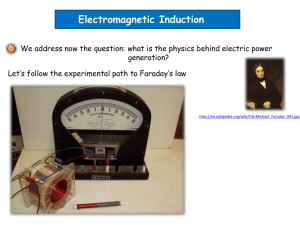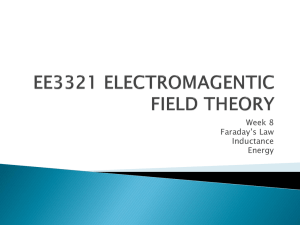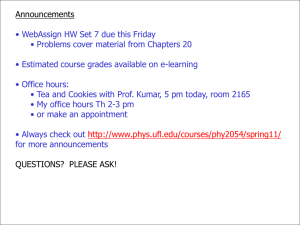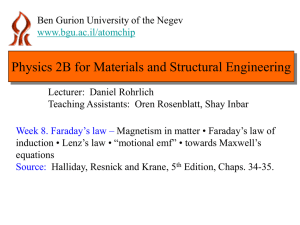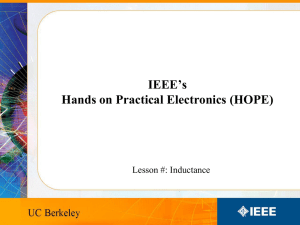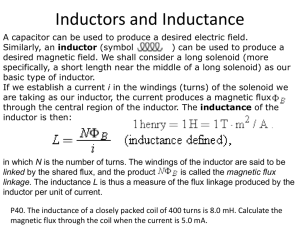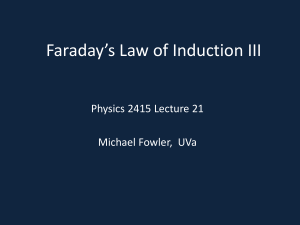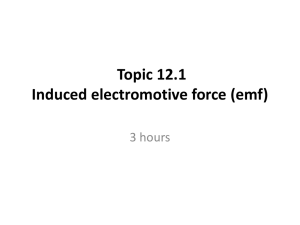Faraday`s Law
advertisement
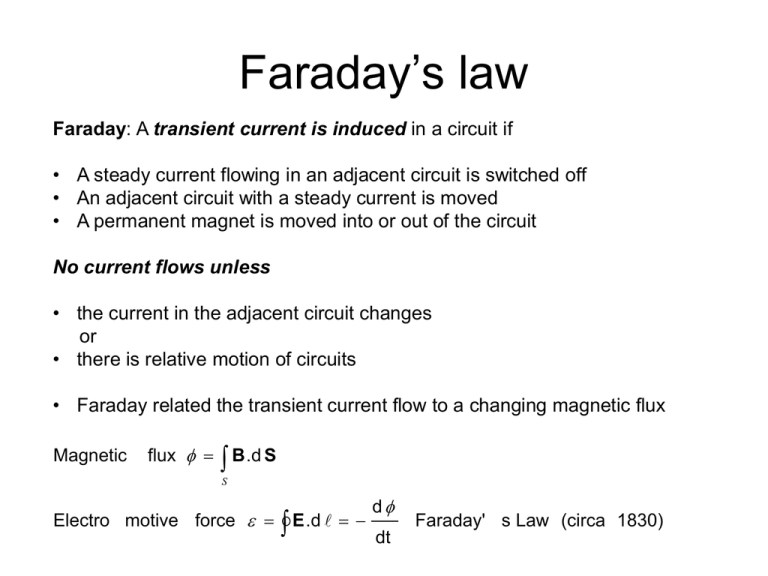
Faraday’s law Faraday: A transient current is induced in a circuit if • A steady current flowing in an adjacent circuit is switched off • An adjacent circuit with a steady current is moved • A permanent magnet is moved into or out of the circuit No current flows unless • the current in the adjacent circuit changes or • there is relative motion of circuits • Faraday related the transient current flow to a changing magnetic flux Magnetic flux B .d S S Electro motive force E .d d dt Faraday' s Law (circa 1830) Faraday’s law T(x,t) Total or convective derivative: d dt df t dt dA dt dB dt f t v . v . f A t B t ∂T(x,t)/∂t dx/dt) . ∂T(x,t)/∂x total derivative ∂T(x,t)/∂t + dx/dt. ∂T(x,t)/∂x scalar field f v . A x B x v magnetic t induction field B x B x v B .v v .B v . B B . v B . v .v . B 0 identity x Faraday’s law Consider two situations: (1) Source of B field contributing to is moving (2) Surface/enclosing contour on which is measured is moving Which situation applies depends on observer’s rest frame S v Situation (1) Rest frame of measured circuit (unprimed frame) B is changing on S because source circuit is moving at v dB dt S B S t E .d d dt B .d S S S B t .d S S’ v Faraday’s law Situation (2) Rest frame of source circuit (primed frame) B’ is changing because measured circuit is moving at v dB ' S ' dt x B ' x v d dt t 0 since source is at rest B '.d S ' x B ' x v .d S ' S' B ' x v .d ' C' B ' S ' S' v x B ' .d ' C' by Stokes' Theorem v S’ Faraday’s law Situation (2) Rest frame of source circuit (primed frame) B’ is changing because measured circuit is moving at v dB ' S ' dt x B ' x v d dt t 0 since source is at rest B '.d S ' x B ' x v .d S ' S' B ' x v .d ' C' B ' S ' S' v x B ' .d ' by Stokes' Theorem C' F ' q v x B ' force on charge q F' q E' E '.d ' C' E .d d Lenz’s Law dt Minus sign in Faraday’s law is incorporation of Lenz’s Law which states The direction of any magnetic induction effect is such as to oppose the cause of the effect It ensures that there is no runaway induction (via positive feedback) or non-conservation of energy Consider a magnetic North Pole moving towards/away from a conducting loop S N B S N v B dS Bind B.dS < 0 Flux magnitude increases d/dt < 0 v dS Bind B.dS < 0 Flux magnitude decreases d/dt > 0 Motional EMF B - Charges in conductor, moving at constant velocity v perpendicular to B field, experience Lorentz force, F = q v x B. Charges move until field established which balances F/q. No steady current established. v B + v - F = q(vxB) + - + F = q(vxB) Completing a circuit does not produce a steady current either Motional EMF emf in rod length L moving through B field, sliding on fixed U shaped wire emf 1 B B B F .d E .d vBL q A Current A I vBL R resistance - R Magnetic flux B .d S + I S d BvL since d(area) dt E .d Magnetic Faraday' s Law (circa 1830) dt flux B .d S S sign implies that field produced opposes the external magnetic + F = q(vxB) vL dt d v - Charge continues to flow while rod continues to move emf induced in circuit equals minus rate of change of magnetic flux through circuit by induced current field. Lenz' s Law. Faraday’s Law in differential form E .d C d dt B .d S S E .d x E .d S C Stokes' Theorem S d dt B .d S x E .d S S S B x E .d S 0 t S xE- B t Faraday' s Law in differenti al form NB x E 0 This part of E field is not generated by scalar potential - Electric vector potential E - xE - Electrosta tic field represente d as gradient B Faraday' s Law t - x 0 xE - B E - B xA t A t of potential Identicall y zero! This E cannot be - - x A t - x A t Represent general E field this way Represent B field as curl of vector potential There are alternativ e choices of A , which produce E and B fields. One choice is a particular gauge . A the same Inductance Self-Inductance in solenoid Faraday’s Law applied to solenoid with changing magnetic flux implies an emf NL B solenoid .area.numb er of loops magnetic o N I . R .NL flux ' linking' NL current 2 d NL emf dt L oN R L 2 2 oN R L 2 2 dI L dt flux loops in length L dI dt (self) inductance 1 henry 1H 1 V/(As -1 ) 50 cm coil with 5cm radius, 5000 turns L 0.5H More typically B L ~ mH or H L I Area of cross section = R2 N loops (turns) per unit length Inductance Work done by emf in LR series circuit VL L dI V dt t R I R potential t Vo difference s t I dI 2 W I V dt' I L R dt' L I' d I' R I dt ' dt' 0 0 0 0 1 2 R t L L I R I dt ' 2 2 0 First term is energy stored in inductor B field Second term is heat dissipated by resistor solenoid inductance L = oN2r2L solenoid field B = oNI W = ½ LI2 = ½ oN2r2L I2 = ½ (oN I)2 r2L/o = ½ B2 volume/o W magnetic dW magnetic dv 1 2o B B dv 2 W electric V 2 2o dW electric dv o 2 E dv 2 V oE 2 2 Inductance Vo LCR series circuit driven by sinusoidal emf VL L dI V dt VL L Q V C C Q V C Q R V C Q R Q V cos( t) LQ o C R Q 1 Q V o cos( t) Q L LC L Resonance at o 1 LC R IR C R Q R I Q L m x m x kx Fo cos( t) x x o2 x o Fo m cos( t) k m elastic exchange of field energy elastic exchange of kinetic and potential energy Displacement current B o j j .j 1 o .j 1 o B . B 0 t Ampere’s Law 0 for non - steady currents Problem! Continuity equation Steady current implies constant charge density so Ampere’s law consistent with the continuity equation for steady currents (only). Ampere’s law inconsistent with the continuity equation (conservation of charge) when charge density is time dependent. Displacement current j ? Add term to LHS such that taking Div makes LHS also identically equal to zero: .E t o o B . j .? 0 or . j . j 0 o .E o .E 1 Displacement current in vacuum (see later) E . o . j t t The extra term is in the bracket extended Ampere’s Law (Maxwell 1862) 1 E j B o t o B o j o o E t Displacement current Relative magnitude of displacement and conduction currents E B o j o t E E o cos( t) jσ E o E t E o s in ( t) ty ~ 10 m 8 σ electric conductivi -1 -1 E t 8.854x10 8 j Frequency 10 12 for Cu ~ 10 19 rad s -1 is in hard x - ray range if currents same order of magnitude Maxwell Equations in Vacuum Maxwell equations in vacuum .E Gauss' Law o .B 0 E Absence B monopoles Faraday' s Law t B o j o o of magnetic E t Extended Ampere' s Law

